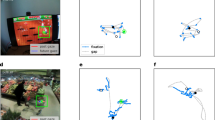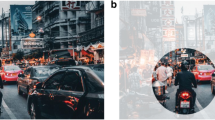Summary
The hypothesis that proprioceptively perceived limb position drifts during visual occlusion was re-examined by combining some of the protocols used in previous experiments. Sixteen adult subjects made judgements of static limb position during visual occlusion lasting up to 2 min. In addition, the effect of brief 250 ms “glimpses” of the limb, occasional proprioceptive stimulation and directed attention were examined. Despite, conflicting evidence from earlier experiments, there was clear evidence of a drift in perceived limb position, towards the body, during visual occlusion. This drift was halted if brief glimpses of the limb were provided, or minor re-positioning (without vision) was allowed. In neither case, however, did the supplementary cues reset limb position to its originally perceived position. Drift was amplified when subjects attempted to attend to limb position rather than perform a secondary tracking task. The results are not easily accounted for if drift is considered purely as an effect of peripheral sensor adaptation. A notion of central-drift between visual and proprioceptive maps is suggested as an alternative hypothesis.
Similar content being viewed by others
References
Bushnell MC, Goldberg ME, Robinson DL (1981) Behavioural enhancement of visual responses in monkey cerebral cortex. I. Modulation in posterior parietal cortex related to selective visual attention. J Neurophysiol 46:755–772
Del Ray P, Lichter J (1971) Accuracy in horizontal arm positioning. Res Q 42:150–155
Grossberg S, Kuperstein M (1989) Neural dynamics of adaptive sensory-motor control. Pergamon, New York
Huynh H, Feldt LS (1970) Conditions under which mean square ratios in repeated measures designs have exact F-distributions. J Am Statistic Ass 65:1582–1589
Jeannerod M (1989) The neural and behavioural organisation of goal directed movements. Clarendon Press, Oxford
Lee WA, Kelso JAS (1979) Properties of slowly adapting joint receptors do not readily predict perception of limb position. J Human Movem Stud 5:171–181
Moylan JJ (1964) Kinesthetic figurai after effects: satiation or contrast. J Exp Psych 67:83–90
Paillard J, Brouchon M (1968) Active and passive movements in the calibration of position sense. In: Freedman SJ (ed) The neuropsychology of spatially oriented behavior. Dorsey Press, Illinois, pp 37–56
Prablanc C, Echallier JF, Komilis E, Jeannerod M (1979) Optimal response of eye and hand motor systems in pointing at a visual target. II. Static and dynamic visual cues in the control of hand movements. Biol Cybern 35:183–187
Spray J (1986) Absolute error revisited. J Motor Behav 18:225–238
Stein JF (1989) Representation of egocentric space in the posterior parietal cortex. Q J Exp Physiol 74:583–606
Von Hofsten C, Rosblad B (1988) The integration of sensory information in the development of precise manual pointing. Neuropsychologia 26:805–821
Zipser D, Anderson RA (1988) Back propagation learning simulates response properties of a subset of posterior parietal neurons. Nature 331:679–684
Author information
Authors and Affiliations
Rights and permissions
About this article
Cite this article
Wann, J.P., Ibrahim, S.F. Does limb proprioception drift?. Exp Brain Res 91, 162–166 (1992). https://doi.org/10.1007/BF00230024
Received:
Accepted:
Issue Date:
DOI: https://doi.org/10.1007/BF00230024




